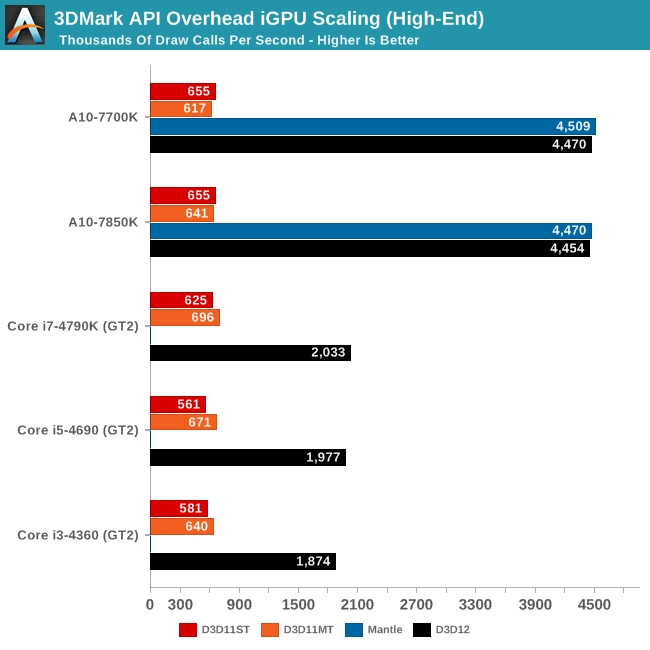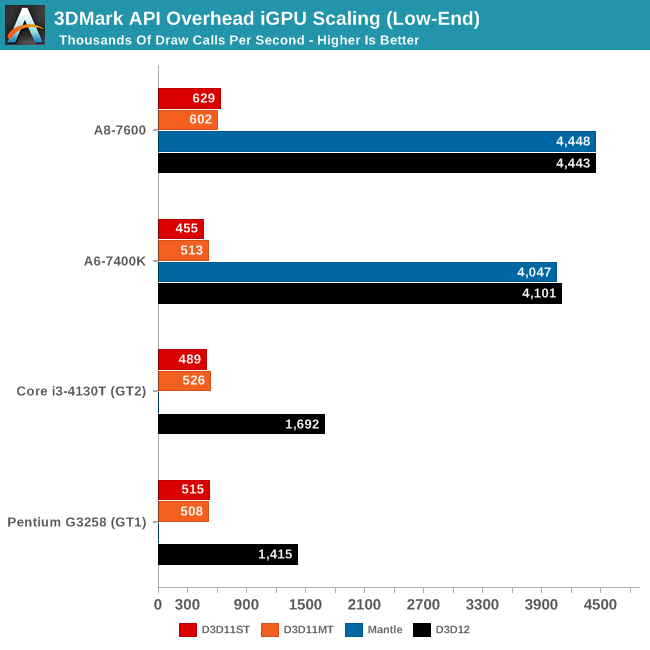Exploring DirectX 12: 3DMark API Overhead Feature Test
by Ryan Smith & Ian Cutress on March 27, 2015 8:00 AM EST- Posted in
- GPUs
- Radeon
- Futuremark
- GeForce
- 3DMark
- DirectX 12
Integrated GPU Testing
Switching gears from high performance discrete GPUs, we have our integrated GPUs. From a high level overview the gains from DirectX 12 are not going to be quite as large here as they are with dGPUs due to the much lower GPU performance, but there is still ample opportunity benefit from increased draw call performance.
Here we have Intel’s Haswell CPUs, and AMD’s Kaveri APUs. We'll start off with the higher-end processors, the Intel Core i3/i5i7 and AMD A10/A8.

As expected, at the high-end the performance gains from DirectX 12 are not quite as great as they were with the dGPUs, but we’re still seeing significant gains. The largest gains of course are found with the AMD processors, thanks to their much stronger iGPUs. From DX11ST to DX12 we’re seeing a surprisingly large 6.8x increase in draw call performance, from 655K to 4,470K.
As to be expected, with a relatively weak CPU, AMD’s DX11 draw call performance isn’t very strong here relative to their strong GPU and of course our more powerful dGPUs. Still, it ends up being better than Intel (who otherwise has the stronger CPU), so we see AMD offering better draw call throughput at all levels. Ultimately what this amounts to is that AMD has quite a bit more potential under DX12.
Mantle meanwhile delivers a very slight edge over DX12 here, although for all practical purposes the two should be considered tied.
Meanwhile for the Intel CPUs, the gains from DX12 aren’t quite as large as with the AMD processors, but they’re still significant, and this is why Intel is happily backing DX12. All 3 processors share the same GT2 GPU and see similar gains. Starting from a baseline of 625K draw calls under DX11 – almost identical to AMD – the i7-4790K jumps up by 3.2x to 2,033K draw calls under DX12. The i5 and the i3 processors see 1,977K and 1,874K respectively, and after adjusting for clockspeeds it’s clear that we’re GPU command processor limited at all times here, hence why even a 2 core i3 can deliver similar gains.
Intel does end up seeing the smallest gains here, but again even in this sort of worst case scenario of a powerful CPU paired with a weak CPU, DX12 still improved draw call performance by over 3.2x. This means that in the long run even games that are targeting lower-performance PCs still stand to see a major increase in the number of draw calls they can use thanks to DirectX 12.

The story is much the same with our lower performance processors. AMD continues to see the largest gains and largest absolute performance under DirectX 12. With a 7x performance increase for the A8, even this weaker processor benefits greatly from the use of a low-level API.
The Intel processors see smaller gains as well, but they too are similarly significant. Even the Pentium with its basic GT1 processor and pair of relatively low clocked CPU sees a 2.7x increase in draw call performance from DirectX 12.










113 Comments
View All Comments
tipoo - Friday, March 27, 2015 - link
4X gains seen herehttp://www.pcworld.com/article/2900814/tested-dire...
Ryan Smith - Friday, March 27, 2015 - link
Sorry, that was an error in that table. We didn't have the 4770R for this article.geekfool - Saturday, March 28, 2015 - link
hhm pcw says " All of our tests were performed at 1280x720 resolution at Microsoft's recommendation."if that's the case with your tests too then its seems that the real test today should be 1080p and a provisional 4k/UHD1 to get a set of future core numbers regardless of MS's wishes...
Ryan Smith - Sunday, March 29, 2015 - link
720p is the internal rendering resolution, and is used to avoid potential ROP bottlenecks (especially at the early stages). This is supposed to be a directed, synthetic benchmark, and the ability to push pixels is not what is intended to be tested.That said, the actual performance impact from switching resolutions on most of these GPUs is virtually nil since there's more than enough ROP throughput for all of this.
Winterblade - Friday, March 27, 2015 - link
Very interesting results, and very informative article, the only small caveat I find is that for proper comparison of 2, 4 and 6 cores (seems to be one of the focal points of the article) the clock should be the same for all 3 configurations, it is a bit misleading otherwise. The difference seems to be around 10 - 15% in going from 4 to 6 cores but there is also a 10% difference in clock rate between them.chizow - Friday, March 27, 2015 - link
Fair point, it almost looks like they are trying to artifically force some contrast in the results there. Biggest issue I have with that is you are more likely to find higher clocked 4-cores in the wild since they tend to overclock better than the TDP and size limited 6-core chips.That's the tradeoff any power-user faces there, higher overclock on that 4790K (and soon Broadwell-K) chip or the higher L3 cache and more cores of a 6-core chip with lower OC potential.
dragonsqrrl - Friday, March 27, 2015 - link
I got 1.7M draw calls per second with an i7-970 and GTX480 in DX11, and 2.3M in DX11MT. Pretty much identical to every other Nvidia card benchmarked. Interested to see what kind of draw call gains I get with a 480 once Windows 10 and DX12 come out with finalized drivers.godrilla - Friday, March 27, 2015 - link
Vulkan seems more attractive for devs though.The battle of the APIs incoming.
junky77 - Friday, March 27, 2015 - link
Well, currently, the limiting factor is almost always the GPU, with with a powerful GPU, unless we are talking AMD CPUs which are TDP limtied in many cases or an I3 and even then the differences are not greatSo, I think that it's mainly a look for the future, allowing higher draws scenes, potentially
Mat3 - Friday, March 27, 2015 - link
Would be interesting to see how the FX-8350 compares to the i7-4960X for this test.